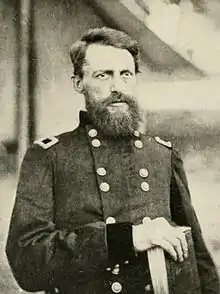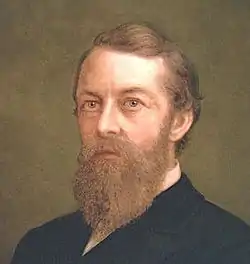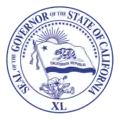George Stoneman
George Stoneman Jr. (August 8, 1822 – September 5, 1894) was a United States Army cavalry officer, trained at West Point, where his roommate was Stonewall Jackson. In the Civil War he became Adjutant to George B. McClellan, who did not appreciate the use of centralized cavalry, and was therefore outperformed by the Confederates, who did.
George Stoneman Jr. | |
|---|---|
 George Stoneman during the American Civil War | |
| 15th Governor of California | |
| In office January 10, 1883 – January 8, 1887 | |
| Lieutenant | John Daggett |
| Preceded by | George C. Perkins |
| Succeeded by | Washington Bartlett |
| Personal details | |
| Born | August 8, 1822 Busti, New York |
| Died | September 5, 1894 (aged 72) Buffalo, New York |
| Political party | Democratic |
| Spouse(s) | Mary Stoneman |
| Children | 4 |
| Military service | |
| Allegiance | United States of America Union |
| Branch/service | United States Army Union Army |
| Years of service | 1846–1871 |
| Rank | |
| Commands | III Corps Cavalry Corps XXIII Corps |
| Battles/wars | American Civil War |
At Chancellorsville, under Joseph Hooker, Stoneman failed in an ambitious attempt to penetrate behind enemy lines, getting bogged down at an important river crossing. Hooker's sharp criticism of Stoneman may have been partly aimed at deflecting the heavy blame being directed at himself for the loss of this major battle that most generals believed to be winnable.
While commanding cavalry under William Tecumseh Sherman in Georgia, Stoneman was captured, but soon exchanged. During the early years after the American Civil War, Stoneman commanded occupying troops at Memphis, Tennessee, who were stationed at Fort Pickering. He had turned over control of law enforcement to the civilian government by May 1866, when the Memphis riots broke out and the major black neighborhoods were destroyed. When the city asked for help, he suppressed the white rioting with use of federal troops. He later moved out to California, where he had an estate in the San Gabriel Valley. He was elected as governor of California, serving between 1883 and 1887. He was not nominated a second time.
Early life
Stoneman was born on a family farm in Busti, New York, the first child of ten. His parents were George Stoneman Sr., a lumberman and justice of the peace, and Catherine Rebecca Cheney Aldrich. He studied at the Jamestown Academy and entered the United States Military Academy in 1842; his roommate at West Point was future Confederate General Thomas J. "Stonewall" Jackson. He graduated 33rd in his class of 59 cadets in 1846. His first assignment was with the 1st U.S. Dragoons, with which he served across the West and in California. He was the quartermaster of the Mormon Battalion, which marched from Fort Leavenworth, Kansas, to San Diego, California. He fought in the Yuma War and was responsible for survey parties mapping the Sierra Nevada range for railroad lines. After promotion to captain of the 2nd U.S. Cavalry in March 1855, he served mainly in Texas until 1861.
Civil War service

At the start of the Civil War Stoneman was in command of Fort Brown, Texas, and refused the order of Maj. Gen. David E. Twiggs to surrender to the newly established Confederate authorities there, escaping to the north with most of his command. Returning east, he was reassigned to the 1st US Cavalry and promoted to major on May 9, 1861. Stoneman then served as adjutant to General George McClellan during his campaign in Western Virginia during the summer. After McClellan became commander of the newly-formed Army of the Potomac, he assigned Stoneman as his chief of cavalry; Stoneman was promoted to brigadier general of volunteers on August 13.[1] Stoneman had a difficult relationship with McClellan as he desired to use the cavalry as a raiding and combat force, while McClellan merely envisioned it as an extension of the army signal corps. The Army of the Potomac's cavalry performed poorly in the Eastern Theater during the spring and summer of 1862, being soundly out-generaled and out-fought by Confederate cavalry.
On November 22, 1861, Stoneman married Mary Oliver Hardisty of Baltimore. They would have four children.
Stoneman was reassigned to the infantry and received command of the 1st Division of the III Corps on September 10 after its former commander, Maj. Gen. Phil Kearny, had been killed a week earlier. The III Corps remained in Washington, D.C., during the Maryland Campaign. On October 30, Stoneman gained command of the corps. At Fredericksburg, it formed part of Maj. Gen. Joseph Hooker's Center Grand Division and helped drive back a Confederate assault during the battle. Following Fredericksburg, Hooker became commander of the Army of the Potomac and decided to organize the cavalry into a single corps with Stoneman at its head.
Stoneman's raids

The plan for the Battle of Chancellorsville was strategically daring. Hooker assigned Stoneman a key role in which his Cavalry Corps would raid deeply into Robert E. Lee's rear areas and destroy vital railroad lines and supplies, distracting Lee from Hooker's main assaults. However, Stoneman was a disappointment in this strategic role. The Cavalry Corps got off to a good start in May 1863, but quickly bogged down after crossing the Rapidan River. During the entire battle, Stoneman accomplished little, and Hooker considered him one of the principal reasons for the Union defeat at Chancellorsville.[2] Hooker needed to deflect criticism from himself and relieved Stoneman of his cavalry command, sending him back to Washington, D.C., for medical treatment (chronic hemorrhoids, exacerbated by cavalry service),[3] where in July he became a Chief of the U.S. Cavalry Bureau, a desk job. A large cavalry supply and training depot on the Potomac River was named Camp Stoneman in his honor.
In early 1864, Stoneman was impatient with garrison duty in Washington and requested another field command from his old friend Maj. Gen. John Schofield, who was in command of the Department of the Ohio. Although originally slated for an infantry corps, Stoneman assumed command of the Cavalry Corps of what would be known as the Army of the Ohio. On March 30, he was also promoted to lieutenant colonel in the regular army. As the army fought in the Atlanta Campaign under Maj. Gen. William T. Sherman, Stoneman and his aide, Myles Keogh, were captured by Confederate soldiers on July 31, 1864, outside Macon, Georgia.[4] However, the 5th Indiana Cavalry Regiment under Col. Thomas Butler made a valiant stand, allowing the rest of his forces to retreat. They were surrendered as well, despite protest by Col. Butler.[5] Stoneman became the highest-ranking Union prisoner of war, and he remained prisoner for three months.
Stoneman was exchanged relatively quickly, based on the personal request of Sherman to the Confederates, and returned to duty. In December 1864 he led a raid from East Tennessee into southwestern Virginia. He led further raids in 1865, into Virginia and North Carolina and took Salem, Martinsville, and other towns, destroyed the Moratock Iron Furnace (a Confederate foundry), and at Salisbury, attempted to free about 1,400 prisoners, but the prisoners had been dispersed by the time he arrived. In recognition of his service, he was brevetted major general in the regular army. His command nearly captured Confederate president Jefferson Davis during his flight from Richmond, Virginia. In June 1865 he was appointed commander of the Department of Tennessee and administered occupied Memphis. The Memphis riots broke out among the still rebellious citizens, who were angry at the presence of African-American Federal soldiers in the military government. Stoneman was criticized for inaction and was investigated by a congressional committee, although he was exonerated.
Postbellum politics
In 1866 Stoneman became opposed to the radical policies of Reconstruction and joined the Democratic Party. As he administered the military government in Petersburg, Virginia, he established a reputation of applying more moderate policies than some of the other military governors in Reconstruction, which policies eased some of the reconciliation pain for white Virginians.
On July 28, 1866, Stoneman was promoted to colonel in the regular army and assigned command of the 21st US Infantry.
He also commanded federal troops at Fort Pickering at Memphis. He had turned police power over to the local civil government, whose officials had said they were ready to manage it. But the local government requested him to suppress white rioting in May 1866, after three days of violence that left many blacks dead and wounded, and much of their property destroyed. His actions were investigated by Congress, and he was exonerated.
Stoneman mustered out of volunteer service on September 1, 1866 and reverted to the regular army rank of colonel. He took command of the Department of Arizona, First Military District, headquartered at Drum Barracks. He was a controversial commander in that role because of his dealings with Indian uprisings and was relieved of command in June 1871. Although out of active duty, Stoneman remained on the army's roster until he officially retired in 1882 upon reaching the mandatory retirement age of 64.
Stoneman was a First Class Companion of the California Commandery of the Military Order of the Loyal Legion of the United States.
California

Stoneman moved to California, the place of which he had dreamed since his service as a young officer before the war. He and his wife settled in the San Gabriel Valley on a 400-acre (160 ha) estate called Los Robles, which is now a California Historical Landmark.[6] He was appointed as a state railroad commissioner, serving from 1876 to 1878.
In 1882, Stoneman was elected governor of California as a Democrat and served a single four-year term. He was not renominated by his party for a second term. Some time later his house was destroyed by fire, an event rumored to be the work of his political enemies. Stoneman was broken financially by the disaster and was in poor health.
He returned to New York State for medical treatment. He died following a stroke in Buffalo, New York, on September 5, 1894, at age 72. He is buried in the Bentley Cemetery in Lakewood, New York.
Legacy and honors
Stoneman's raids into North Carolina and Virginia in the last weeks of the war were memorialized by songwriter Robbie Robertson of The Band, in the 1969 song "The Night They Drove Old Dixie Down".
Virgil Caine is the name, and I served on the Danville train,
Till Stoneman's cavalry came and tore up the tracks again ...
Stoneman is not mentioned in the 1971 recording of the song by Joan Baez, in which she substitutes "so much cavalry" for "Stoneman's cavalry". Baez told Kurt Loder of Rolling Stone magazine that she had learned the song by listening to the track on The Band's album. Having never seen the printed lyrics, she sang the words as she (mis)heard them.[7]
Stoneman Avenue in Alhambra, California, was named in his honor. Camp Stoneman, near Pittsburg, California, was the place from where many soldiers shipped out to the Pacific Theater in World War II and the Korean War, and is remembered by Stoneman Elementary School.[8] Stoneman Elementary School in San Marino, California, is built on Stoneman's Los Robles Ranch Property. In 1885 California, which owned Yosemite at the time, built a luxury hotel with accommodations for 150 guests near the present location of Curry Village and named the hotel Stoneman House. The adjoining Stoneman Meadow takes its name from the hotel. The nearby Stoneman Bridge takes its name from the meadow. The hotel burned to the ground in 1896.[9] Stoneman Lake in Arizona is also named in his honor. General George Stoneman Business Park, the site of the Southern Tier Brewery, is located on the Stoneman family farm in the town of Busti, New York.
General Stoneman's name is engraved on the Sonoma Veterans Memorial Park Star of Honor due to his time there before the Civil War.
Notes
- "Californians and the Military: George Stoneman Jr.: Civil War General and California Governor". California State Military Museum, California Military Department (MilitaryMuseum.org). Retrieved 19 May 2019.
- Sears, p. 440.
- Gerleman, p. 1874.
- Seibert, David. "Stoneman Raid". GeorgiaInfo: an Online Georgia Almanac. Digital Library of Georgia. Retrieved 7 November 2016.
- A Hoosier in Andersonville, by Robert Haughtalen, pp. 2–3
- California State Parks, Office of Historic Preservation (2012). "Governor Stoneman Adobe, Los Robles". State of California. Retrieved 7 February 2012.
- Loder, Kurt (1983-04-14). "Joan Baez: The Rolling Stone Interview". Rolling Stone (393).
- Stoneman Elementary School Archived 2010-05-30 at the Wayback Machine
- Hutchings' guide Yo Semite Valley and Big Trees (1895) and One Hundred Years in Yosemite (C.P. Russell, 1947)
References
- This article incorporates text from a publication now in the public domain: Gilman, D. C.; Peck, H. T.; Colby, F. M., eds. (1905). . New International Encyclopedia (1st ed.). New York: Dodd, Mead.
- Eicher, John H., and David J. Eicher. Civil War High Commands. Stanford, CA: Stanford University Press, 2001. ISBN 0-8047-3641-3.
- Gerleman, David J. "George H. Stoneman Jr." In Encyclopedia of the American Civil War: A Political, Social, and Military History, edited by David S. Heidler and Jeanne T. Heidler. New York: W. W. Norton & Company, 2000. ISBN 0-393-04758-X.
- Sears, Stephen W. Chancellorsville. Boston: Houghton Mifflin, 1996. ISBN 0-395-87744-X.
- Warner, Ezra J. Generals in Blue: Lives of the Union Commanders. Baton Rouge: Louisiana State University Press, 1964. ISBN 0-8071-0822-7.
Further reading
- "A Civil War Cavalry History: Stoneman's Raid". American Civil War Homepage.
- "George Stoneman, 1883–1887". The Governors' Gallery. California State Library. Retrieved 2013-04-09.
- Fordney, Ben Fuller. George Stoneman: A Biography of the Union General. Jefferson, NC: McFarland, 2008. ISBN 978-0-7864-3225-7.
External links
 Media related to George Stoneman at Wikimedia Commons
Media related to George Stoneman at Wikimedia Commons
| Party political offices | ||
|---|---|---|
| Preceded by Hugh J. Glenn |
Democratic nominee for Governor of California 1882 |
Succeeded by Washington Bartlett |
| Political offices | ||
| Preceded by George C. Perkins |
Governor of California 1883–1887 |
Succeeded by Washington Bartlett |
| Military offices | ||
| Preceded by Samuel P. Heintzelman |
Commander of the III Corps (Army of the Potomac) October 30, 1862 – February 5, 1863 |
Succeeded by Daniel E. Sickles |
